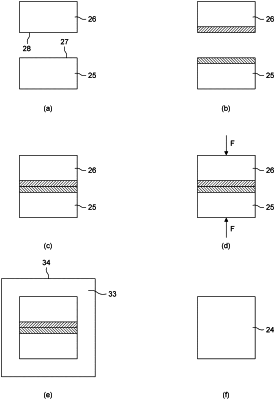| CPC B22F 7/064 (2013.01) [B22F 3/00 (2013.01); B22F 3/10 (2013.01); B22F 10/00 (2021.01); B22F 10/10 (2021.01); B33Y 10/00 (2014.12); B22F 9/24 (2013.01)] | 12 Claims |

|
1. Method of manufacturing an object by joining a first component and a second component, the method comprising the following steps:
providing the first component comprising metal powder with a first alloy composition and a first soluble binder, the first component having a first joining surface,
providing the second component comprising metal powder with a second alloy composition and a second soluble binder, the second component having a second joining surface to be joined with the first joining surface;
wherein the first alloy composition and the second alloy composition both consist of a plurality of chemical elements, and wherein the chemical elements are chosen so that, for each of the chemical elements being present in an amount higher than 0.5 weight % in each of the alloy compositions, that chemical element is comprised both in the first and second alloy composition, and
for the chemical elements being present in the first alloy composition in amounts of up to 5.0 weight %, the amount of that chemical element differs by at most 1 percentage point between the first and second alloy compositions, and
for the chemical elements being present in the first alloy composition in amounts of more than 5.0 weight %, the amount of that chemical element differs by at most 3 percentage point between the first and second alloy compositions;
enabling the joining by:
arranging a mixture comprising dissolved third binder and metal powder with a third alloy composition between the first joining surface and the second surface, such as on at least one of the first and second joining surfaces, wherein the third alloy composition consists of a plurality of chemical elements which are chosen so that, for each of the chemical elements being present in an amount higher than 0.5 weight % of the metal powder in the mixture:
for the chemical elements being present in the third alloy composition in amounts of up to 5.0 weight %, the amount of that chemical element differs by at most 1 percentage point between the first and third alloy compositions, and
for the chemical elements being present in the third alloy composition in amounts of more than 5.0 weight %, the amount of that chemical element differs by at most 3 percentage point between the first and third alloy compositions, and
arranging the first and second joining surfaces as close together as possible while sandwiching the mixture of dissolved third binder and metal powder there between, and maintaining the first and second joining surfaces in contact with the mixture of dissolved third binder and metal powder for a time period allowing for at least some evaporation of the solvent; and
sintering or oxidizing the first and second components together while maintaining the first and second joining surfaces as close together as possible in order to achieve the object.
|